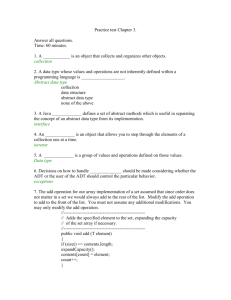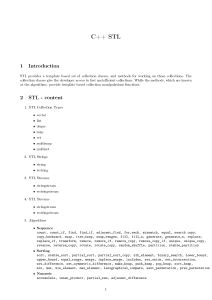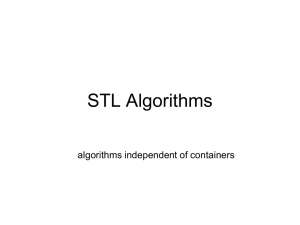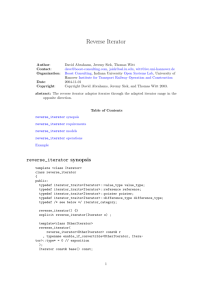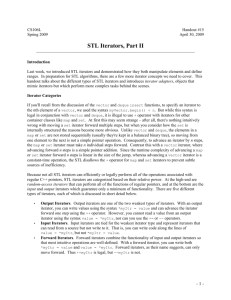page1/page7/files/Reuse STL
advertisement
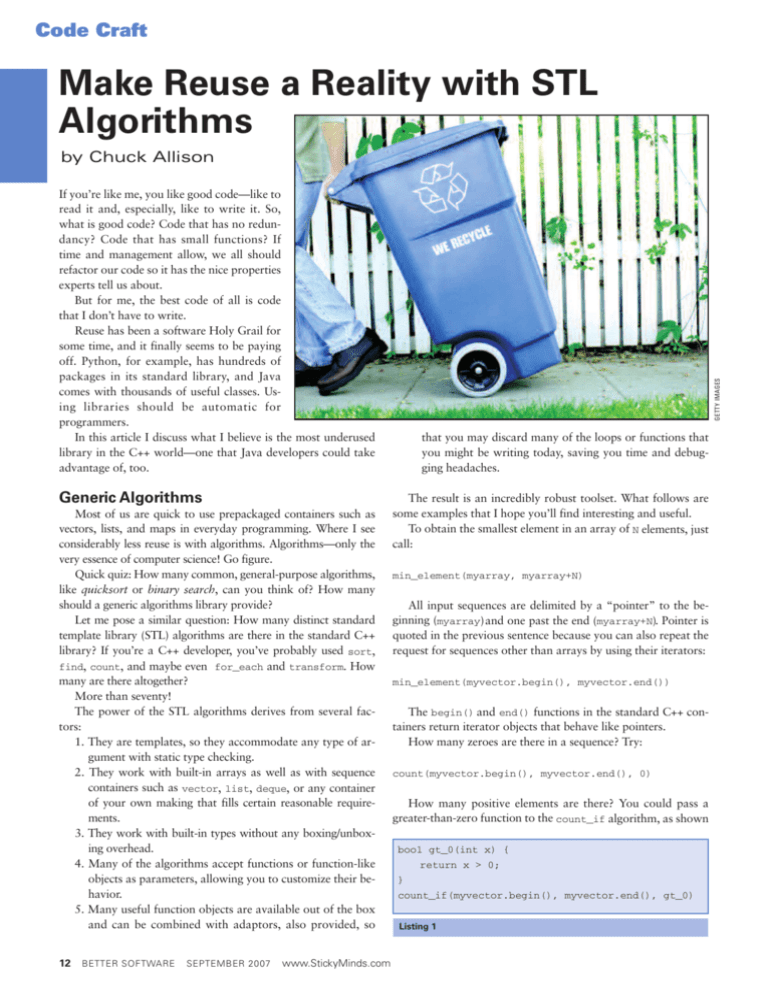
Code Craft
Make Reuse a Reality with STL
Algorithms
If you’re like me, you like good code—like to
read it and, especially, like to write it. So,
what is good code? Code that has no redundancy? Code that has small functions? If
time and management allow, we all should
refactor our code so it has the nice properties
experts tell us about.
But for me, the best code of all is code
that I don’t have to write.
Reuse has been a software Holy Grail for
some time, and it finally seems to be paying
off. Python, for example, has hundreds of
packages in its standard library, and Java
comes with thousands of useful classes. Using libraries should be automatic for
programmers.
In this article I discuss what I believe is the most underused
library in the C++ world—one that Java developers could take
advantage of, too.
Generic Algorithms
Most of us are quick to use prepackaged containers such as
vectors, lists, and maps in everyday programming. Where I see
considerably less reuse is with algorithms. Algorithms—only the
very essence of computer science! Go figure.
Quick quiz: How many common, general-purpose algorithms,
like quicksort or binary search, can you think of? How many
should a generic algorithms library provide?
Let me pose a similar question: How many distinct standard
template library (STL) algorithms are there in the standard C++
library? If you’re a C++ developer, you’ve probably used sort,
find, count, and maybe even for_each and transform. How
many are there altogether?
More than seventy!
The power of the STL algorithms derives from several factors:
1. They are templates, so they accommodate any type of argument with static type checking.
2. They work with built-in arrays as well as with sequence
containers such as vector, list, deque, or any container
of your own making that fills certain reasonable requirements.
3. They work with built-in types without any boxing/unboxing overhead.
4. Many of the algorithms accept functions or function-like
objects as parameters, allowing you to customize their behavior.
5. Many useful function objects are available out of the box
and can be combined with adaptors, also provided, so
12
BETTER SOFTWARE
SEPTEMBER 2007
www.StickyMinds.com
GETTY IMAGES
by Chuck Allison
that you may discard many of the loops or functions that
you might be writing today, saving you time and debugging headaches.
The result is an incredibly robust toolset. What follows are
some examples that I hope you’ll find interesting and useful.
To obtain the smallest element in an array of N elements, just
call:
min_element(myarray, myarray+N)
All input sequences are delimited by a “pointer” to the beginning (myarray)and one past the end (myarray+N). Pointer is
quoted in the previous sentence because you can also repeat the
request for sequences other than arrays by using their iterators:
min_element(myvector.begin(), myvector.end())
The begin() and end() functions in the standard C++ containers return iterator objects that behave like pointers.
How many zeroes are there in a sequence? Try:
count(myvector.begin(), myvector.end(), 0)
How many positive elements are there? You could pass a
greater-than-zero function to the count_if algorithm, as shown
bool gt_0(int x) {
return x > 0;
}
count_if(myvector.begin(), myvector.end(), gt_0)
Listing 1
Code Craft
in listing 1.
All count_if needs is something that can be called as a single-argument function for every element in the given sequence.
To sum the numbers in a file, call:
accumulate(istream_iterator<double>(infile),
istream_iterator<double>(), 0.0);
Function Objects
You might find it easier, though, to use the built-in greater
function object. A function object is just a class that implements
the function call operator (operator()). The greater function
object is a binary function, of course, so it needs to be adapted
to work as a unary function with count_if. Here’s how to
make that happen:
count_if(myvector.begin(), myvector.end(),
bind2nd(greater<int>(), 0))
The bind2nd adaptor function takes something that is
callable as a binary function and wraps it in an object that is
callable with one argument. Whenever the latter is called, it forwards the incoming argument as the first argument to the
original binary function, and the original second argument it
saved becomes the second argument. There also is a bind1st
adaptor.
Do you need to fill a vector with a constant value, expanding
the vector to n elements as you go? Do this:
vector<int> v;
fill_n(back_inserter(v), n, 0);
The back_inserter function wraps a sequence container in
an iterator object that appends to its container every time the
wrapper object itself is assigned a value. If you want random
numbers, use generate_n with rand:
Since accumulate uses the “ + ” operator between its
operands, you can use it to combine a sequence of strings into a
single string:
accumulate(v.begin(), v.end(), string(“”));
Another version of accumulate takes a fourth argument,
which replaces the default addition operator with one of your
choice. Here is an example that multiplies the numbers from a
file together:
accumulate(istream_iterator<double>(infile),
istream_iterator<double>(),
1.0, multiplies<double>());
To compute the sum of the squares of each element requires
a custom function, as shown in listing 3.
int sum_sofar(int b, int a) {
return a*a + b;
}
accumulate(a, a+N, 0, sum_sofar) << endl;
Listing 3
This arrangement takes advantage of the fact that accumulate uses its running result as the first argument to each call of
the binary function passed in the fourth position.
generate_n(back_inserter(v), n, rand)
Suppose you want to read all words from a text
file
and create a new file with each string surifstream f(“myfile“);
rounded
by quotes on a line by itself. Given a
vector<string> v;
suitable
quoting
function, a single call to the
copy(istream_iterator<string>(f), istream_iterator<string>(),
back_inserter(v));
transform algorithm does the job, as shown in
listing 4.
Listing 2
This call to transform sends each string in the
stream
As shown in listing 2, using back_inserter makes short
infile as a parameter to quote and writes the result to
work of populating a container from a file.
the output stream, outfile. The ostream_iterator adaptor
The istream_iterator adaptor
function wraps a file stream in an object string quote(const string& s) {
that behaves like a begin iterator—it
return ‘“‘ + s + ‘“‘;
reads from the file whenever it is ac- }
cessed. The second occurrence of transform(istream_iterator<string>(infile),istream_iterator<string>(),
istream_iterator (without an arguostream_iterator<string>(outfile,”\n”), quote);
ment) behaves like a past-the-end
iterator.
Listing 4
Take a breath, and let’s keep going.
If you do your own taxes, you’ve seen the phrase “If the wraps a stream in an object that writes the value it is assigned to
amount is less than zero, enter zero” (much to our dismay). The the stream, followed by a separator character.
following variation of the replace algorithm replaces all negaI like to play the game Text Twist on my PDA. You get the
tive numbers in an array with zero:
letters of a six-letter word in random order with the goal of discovering all words greater than or equal to length three. To
continue from one screen to the next, you need to find at least
replace_if(a, a+5, bind2nd(less<int>(), 0), 0)
www.StickyMinds.com
SEPTEMBER 2007
BETTER SOFTWARE
13
Code Craft
one of the possible six-letter words within the given time limit.
Just for grins, I wrote a program to discover the n-letter words
in an n-letter string. First I read the words from an open source
dictionary into a set data structure as shown in listing 5.
set<string> words;
ifstream ifs(“2of12inf.txt”);
string word;
while (ifs >> word)
words.insert(word);
Listing 5
Next I sort the six letters in preparation for examining all
possible permutations:
sort(s.begin(), s.end());
// s contains the six letters
Now it’s just a matter of determining each possible arrangement of the letters and searching the dictionary for a match, as
shown in listing 6.
do {
if (words.find(s) != words.end())
cout << s << endl;
} while (next_permutation(s.begin(), s.end()));
Listing 6
14
BETTER SOFTWARE
SEPTEMBER 2007
www.StickyMinds.com
The next_permutation algorithm replaces its sequence
with the next arrangement in lexicographical order, so it’s important to sort the letters first or you’ll miss possibilities. This
isn’t a one-line program, but it’s readable and concise.
The implementation of these functions and algorithms is actually fairly straightforward, but you don’t have to know how
to implement them to use them. Once you get used to the idea
of iterators, function objects, and adaptors, you can use the STL
algorithms to write more declarative code. This means using
fewer brain cycles and less code real estate spent in crafting
loops and function definitions. Java programmers can find these
algorithms in JGL from Recursion Software. {end}
Chuck Allison developed software for twenty years before becoming a professor of computer science at Utah Valley State
College. He was senior editor of the C/C++ Users Journal and is
founding editor of The C++ Source. He is also the author of two
C++ books and gives onsite training in C++, Python, and Design
Patterns.
On a scale from 1 to 5, how
would you rank yourself on the
“I Reuse Software” scale? How
well do you know the standard
libraries of the languages you use?
M
Follow the link on the StickyMinds.com
homepage to join the conversation.

